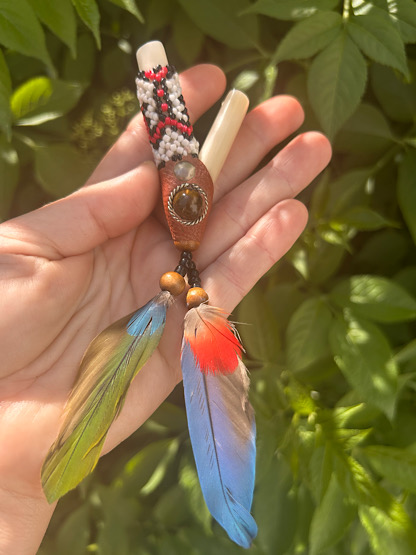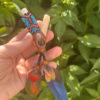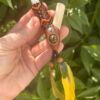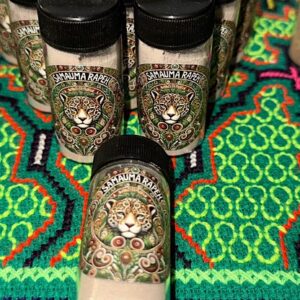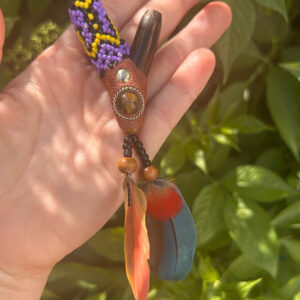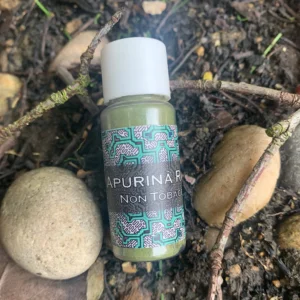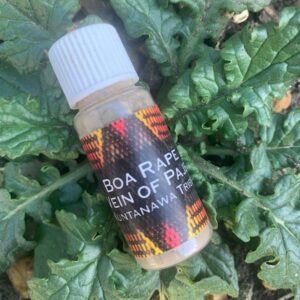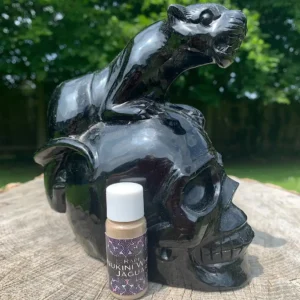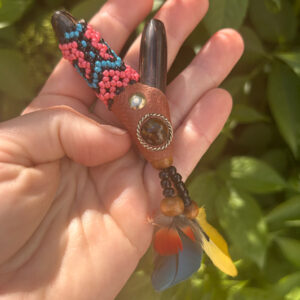Shipibo Lama Bone Kuripe
$66.03
Beaded with Shipibo Design & Macaw Feathers
A beautiful symbolic self-applicator for Rapé, combining grounding materials with traditional design. Each element supports focus, clarity & presence during your practice.
Features:
-
Lama bone for grounding and ancestral connection
-
Shipibo-inspired beadwork to support focus and intention
-
Macaw feathers to promote clarity, breath, and energy movement
-
V-shaped Kuripe for balanced, self-administered Rapé application
-
Handmade; each piece is one of a kind
Handmade Lama Bone Kuripe with Shipibo Glass Beads,Tigers Eye Crystal & Macaw Feathers
This handmade Kuripe is a self-applicator designed for Rapé, crafted with lama bone, Shipibo-style glass beadwork, and finished with vibrant macaw feathers.
It combines function with meaningful materials deeply rooted in spiritual and cultural traditions, making it both a practical tool and a symbolic addition to your ceremonial or meditative practice.
Components & Their Meaning
Lama Bone
Lama bone brings strong grounding energy. Many traditions view bone as a connection to ancestors, representing endurance and transformation. Using a bone applicator helps maintain focus, stability, and a rooted presence, especially during emotionally intense or energetically charged moments.
Shipibo Glass Beadwork (Icaros Design)
The glass bead patterns draw inspiration from the geometric visuals tied to Icaros — the healing songs of the Shipibo people. These designs do more than decorate; they symbolize energy flow, protection, and alignment. They encourage concentration and intention-setting, vital elements of any focused Rapé session.
Tiger’s Eye Crystal
This Kuripe features a tiger’s eye crystal, known for its grounding and protective qualities. Tiger’s eye is believed to enhance focus, courage, and clarity while balancing emotional energy. Its presence supports mental strength and resilience, helping you stay centered during your Rapé practice. The crystal complements the other natural elements, adding a layer of energetic stability and intention to your ceremonial experience.
Macaw Feathers
Macaw feathers traditionally act as messengers, symbolizing clarity, breath, and expanded awareness. Incorporating feathers honors the natural world and connects with the element of air, which supports the movement of energy, particularly during cleansing practices like Rapé.
Purpose & Use
This Kuripe allows you to self-administer Rapé, delivering the medicine evenly into each nostril. Its ergonomic form promotes independent application while helping maintain your focus and presence throughout the process. Because each piece is handcrafted, expect natural variations in bead patterns, feathers, and bone texture — these differences enhance its uniqueness.
Using this Kuripe supports clarity, grounding, and intentional practice.
What Is Rapé?
Rapé (pronounced ha-PAY) is a traditional plant medicine used by Indigenous tribes in the Amazon. It consists of a finely ground blend of sacred plants, ashes, and mapacho tobacco. Applied through the nose, Rapé supports mental clarity, grounding, and energetic alignment. For centuries, people have used it in ceremonies, spiritual rituals, and healing practices to clear the mind, release emotional blockages, and reconnect with the body and inner truth.
Purpose of Rapé in Ritual and Personal Practice
Rapé often prepares you for meditation, prayer, or ceremony. It also serves for energetic cleansing and improving focus during daily practices. Its effects typically include grounding, releasing mental and emotional tension, heightening presence, and deepening your connection to intention and spiritual guidance.
Kuripe vs. Tepi: Understanding the Tools
Two traditional tools deliver Rapé:
-
Kuripe: A small, V-shaped pipe designed for self-application. It allows you to blow Rapé into your own nostrils, fostering a private and intentional experience. It’s ideal for solo use, meditative focus, and personal ceremonies.
-
Tepi: A longer, straight pipe used for partner application. Someone else administers the Rapé, commonly during group ceremonies or when guided by a facilitator. Tepi supports shared healing and guided intention-setting.
Choosing Your Pipe
Both Kuripe and Tepi become part of your relationship with Rapé medicine. The Kuripe promotes independence and suits daily personal practice or quiet moments. Meanwhile, the Tepi enhances ceremonial exchanges.
| Weight | 70 g |
|---|---|
| Dimensions | 100 × 80 × 50 mm |
Related products
Sacred Medicine
Sacred Medicine

